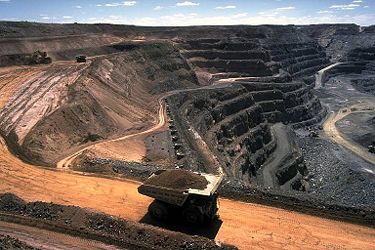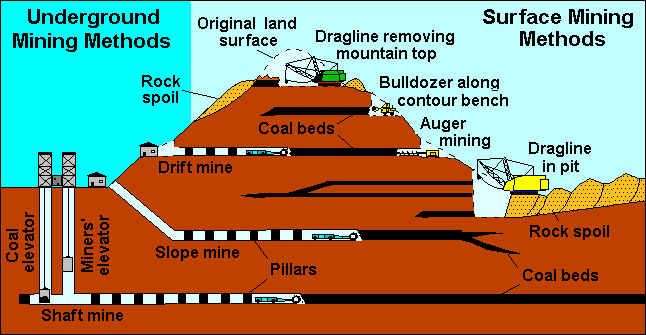Coal mining
Coal tends to exist in seams, which are lateral layers under the earth which may vary in height from 1 or 2 feet to dozens of feet. Mining of coal seams is achieved in several different ways. "Strip" mines scrape coal from the earth's surface; they may be large open pits, or if on a mountain, result in ribbons chewed away from around the perimeter of a mountain at each level where a seam of coal exists. So-called "drift" mines angle horizontally into a mountainside and may be very shallow (i.e., not tall enough for a person to stand up in). "Shaft" mines, also called deep mines, reach down vertically to open into person-sized horizontal tunnels which may be miles from the surface.
Strip mines remove any top soil with bulldozers to get at coal near the earth's surface. Coal is excavated from the ground in what becomes large pits, or else ribbons of stripped land stretch around a mountain. After strip mining has exhausted the available surface coal, the mining company often abandons the site with no restoration, leading to severe erosion problems (with resultant flooding or pollution) and to an unsightly landscape that cannot support plant growth due to the lack of topsoil. Drift mines may be used after strip mining has used up surface coal. Because drift mines tend to be shallow, special equipment may be required to mine them, on which, for example, workers can lie flat on short vehicles moving inside the tunnel. Drift mining is common in the extreme southwest corner of Virginia. Deep mines are similar to those for any other mineral deposit found deep enough in the earth that the cost of removing the overburden is prohibitive. Shafts are dug and veins of coal are excavated and transported to the surface.[1]
Deep and drift mining safety
Early mining methods led to very unsafe mines which often were not even represented on maps at all, or were represented inaccurately.[2] Early mining methods led to irregularly spaced supporting pillars, which often were not represented on maps, or were represented inaccurately. Modern mines have regular pillars at safe intervals of known thickness.
Even using the best known methods, underground coal mining is hazardous work. In addition to the hazard of simple cave-ins, miners have to worry about their tunnels flooding, accumulation of "bad air" (gases lacking enough oxygen), accumulation of explosive gases resulting in fires and/or cave-ins, and many other unexpected problems. Bad air and water can suddenly flood a tunnel if a pocket of the non-oxygenated gas or water is reached without warning when removing coal from a seam.
Following known best practices can reduce the likelihood of extensive loss of life during catastrophic mining accidents. Poor safety records of some mine owners led to the formation of labor unions around the world, and today there remains a high degree of solidarity among mine workers. Mining deaths still occur periodically that arguably could have been prevented with appropriate safety equipment, training and safety procedures.

